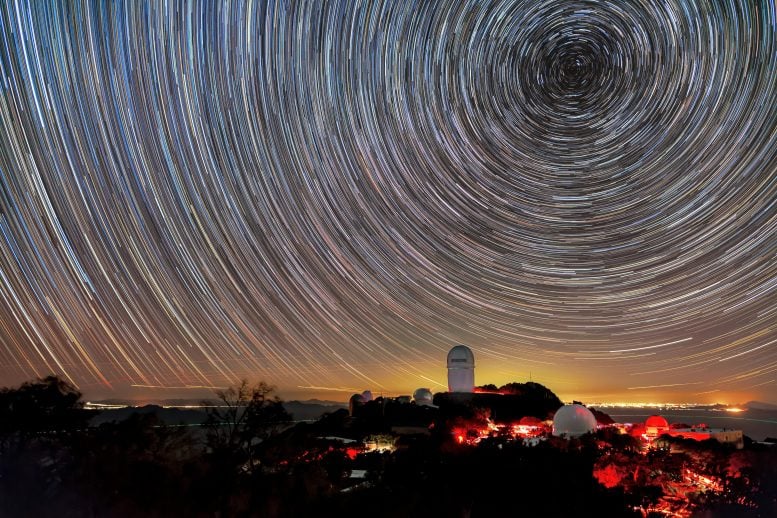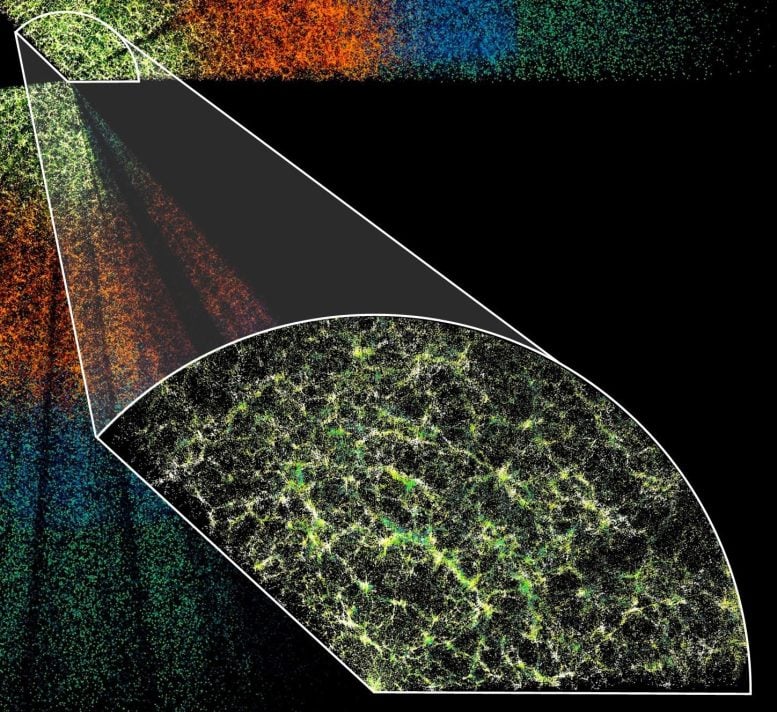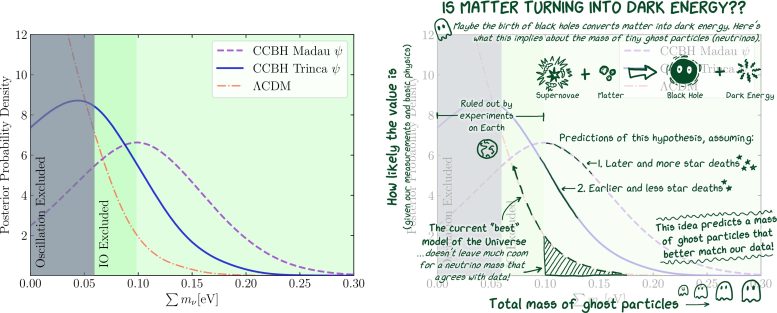
DESI observations suggest black holes may generate dark energy by consuming stellar matter. The idea resolves puzzles about neutrino mass and cosmic expansion.
These are remarkable times for probing some of the most profound mysteries in physics, made possible by advanced experiments and increasingly precise measurements. One of the most compelling questions centers on dark energy, the term given to the unknown force driving the accelerated expansion of the universe.
A study published in Physical Review Letters presents new evidence suggesting that dark energy’s role in cosmic evolution—long assumed to remain constant—may actually vary over time. According to the researchers and their collaborators, the results can be interpreted as a sign that ordinary matter is gradually being transformed into dark energy.
This work is based on observations from Iolkam Du’ag, a mountain in southern Arizona where the Tohono O’odham Nation oversees Kitt Peak National Observatory. At the site, the Dark Energy Spectroscopic Instrument (DESI) scans deep into the history of the universe with 5,000 robotic eyes, each capable of locking onto a different galaxy every 15 minutes.

Black holes as dark energy bubbles
Operating nearly every night, DESI has already charted millions of galaxies and other luminous objects, many dating back to when the universe was less than half its current age.
In this study, the team examined the idea that black holes act as tiny reservoirs of dark energy. Since black holes form when massive stars burn through their fuel and collapse, this concept—known as the cosmologically coupled black hole (CCBH) hypothesis—implies that stellar material is converted into dark energy.
This framework naturally ties the rate of dark energy production and the depletion of matter to a well-studied quantity: the rate of star formation, measured for decades with instruments such as the Hubble Space Telescope and now the James Webb Space Telescope.
“This paper is fitting the data to a particular physical model for the first time and it works well,” said DESI collaboration member Gregory Tarlé, professor emeritus of physics at the University of Michigan and corresponding author of the new report.

Another central aspect of the research involves neutrinos—extremely light, ghost-like particles that are the second most abundant in the universe after photons. Physicists know neutrinos must have a small but nonzero mass, meaning they contribute to the universe’s overall matter content, though their exact masses remain uncertain.
By analyzing DESI’s findings within the CCBH framework, the team obtained values greater than zero for neutrino mass. This outcome aligns with current scientific understanding and improves upon earlier interpretations that had pointed to zero or even negative values.
Developing the CCBH hypothesis
“It’s intriguing at the very least,” Tarlé said. “I’d say compelling would be a more accurate word, but we really try to reserve that in our field.”
DESI is a global collaboration of more than 900 scientists from over 70 institutions. The project is led by Lawrence Berkeley National Laboratory, with construction and operations funded by the U.S. Department of Energy Office of Science. The instrument is installed on the Nicholas U. Mayall 4-meter Telescope at Kitt Peak National Observatory, operated by NSF NOIRLab in Arizona.
The CCBH model was proposed about five years ago by study co-authors Kevin Croker, assistant research scientist at Arizona State University, and Duncan Farrah, a professor at the University of Hawaii. The idea builds on decades of theoretical work exploring black holes as droplets of dark energy rather than destructive “spaghettifying” singularities wrapped in one-way boundaries.
Although the suggestion that dark energy within black holes could influence the cosmos as a whole was unconventional, it proved mathematically viable. This attracted a small group of researchers who began testing how well the hypothesis matched existing observations and large-scale cosmological data.
“Historically, this is the way physics is done. You come up with as many ideas as you can and you shoot them down as fast as you can,” said DESI researcher Steve Ahlen, emeritus professor of physics at Boston University and an early collaborator on the CCBH development.
“You don’t shy away from ideas that are new and different, which is clearly what we need to come up with these days when there are so many mysteries.”
Linking dark energy to star formation
The first data to bolster the CCBH hypothesis came from the unexpected growth of supermassive black holes at the centers of dormant elliptical galaxies, relative to the growth of those galaxies’ stellar populations. But it was data from the first year of DESI, which showed the dark energy density tracking the rate of star formation, that convinced Croker and Farrah to join forces with the DESI Collaboration.
“Working with DESI on the three-year data, it’s been a game-changer,” Croker said of working as a DESI external collaborator on this project. “You’ve got some of the sharpest and most creative researchers in the field lending their hands and hearts. It’s an absolute privilege.”
Other than packets of light called photons, neutrinos are the most abundant particles in the universe. In the time it takes you to read this sentence, hundreds of trillions of neutrinos will pass through your body. But neutrinos rarely interact with their surroundings, meaning they’re constantly zipping through other matter, completely undetected, which is why they’re sometimes referred to as ghost particles.
Scientists know neutrinos have mass, but precisely how much is challenging to measure on account of their ethereal nature. While enormous experiments currently running on Earth work to pin down these numbers, the night sky offers a powerful and complementary avenue for answers.
DESI’s galactic maps contain information on how fast the universe has grown over the past 10 billion years, in turn providing a cosmic inventory of matter and dark energy. But matter comes in three types: cold dark matter, baryons and neutrinos. Early universe measurements from the afterglow of the Big Bang measure the amount of dark matter and baryons long ago. But according to DESI, it seems like there is less matter today when compared to the ancient past. This leaves little room for the neutrinos.
“The data would suggest that the neutrino mass is negative and that, of course, is likely unphysical,” said Rogier Windhorst, Regents’ Professor at ASU’s School of Earth and Space Exploration and co-author of the new study.
CCBH model resolves the neutrino puzzle
Interpreted with the CCBH hypothesis, however, that unphysical issue disappears. Because stars are made of baryons, and black holes convert dead star matter into dark energy, the amount of baryons today has decreased relative to the Big Bang measurements. This allows neutrinos to contribute to the matter budget in the way expected from other measurements.
“You find that the neutrino mass probability distribution points to not only a positive number, but a number that’s entirely in line with ground-based experiments,” Windhorst said. “I find this very exciting.”
While this result gets top billing, the work also highlights other helpful features of the CCBH model.
“The CCBH hypothesis quantifiably links phenomena you would not initially expect to be related,” Farrah said. “It is the mixing of scales, large and small, that runs so counter to our trained linear intuition.”
Matter slows down the growth of the universe, whereas dark energy speeds it up. Because matter is converted to dark energy in the CCBH hypothesis, accelerated expansion happens earlier and so the expansion rate today, the Hubble rate, is a bit larger. This extra boost brings the cosmological measurement of the Hubble rate closer to other measurements, like those from distant exploding stars called supernovae.
The CCBH hypothesis also explains the observed amount of dark energy: It’s not just some magical number set when the universe was born. Dark energy comes from dead stars, so there isn’t any until you have stars, and stars do not form until the universe has grown sufficiently large and cool. Once stars are produced, the amount of dark energy made is directly related to how many stars are made.
Looking forward with DESI
“Working on this project has been both challenging and incredibly fun,” said study co-author Gustavo Niz, a researcher at the University of Guanajuato, Mexico. “This is just another milestone in establishing CCBH as a viable theory. It will take more data, rigorous analysis, and broader scrutiny to determine whether it can become a new paradigm for explaining our universe. Of course, it could also be ruled out as new data emerges.”
Croker said the hypothesis performs well when looking at the universe in the rough, “but data from other experiments that study individual black holes isn’t as compelling. That’s why the hypothesis is interesting. Many different observers can actually test it, hammer it out in real time.”
According to Ahlen, that’s the way science goes. But for scientists who have been working on DESI from the beginning, it’s exciting to see that data coming in is enabling researchers to test new and different hypotheses.
“This is so cool, to be at this point after working on an experiment for so long, to be coming up with exciting results,” said Tarlé, who led the team that built DESI’s robotic eye system. “It’s just wonderful.”
Reference: “Positive Neutrino Masses with DESI DR2 via Matter Conversion to Dark Energy” by S. P. Ahlen, A. Aviles, B. Cartwright, K. S. Croker, W. Elbers, D. Farrah, N. Fernandez, G. Niz, J. W. Rohlf, J. W. Rohlf, G. Tarlé, R. A. Windhorst, J. Aguilar, U. Andrade, D. Bianchi, D. Brooks, T. Claybaugh, A. de la Macorra, A. de Mattia, B. Dey, P. Doel, J. E. Forero-Romero, E. Gaztañaga, S. Gontcho A. Gontcho, G. Gutierrez, D. Huterer, M. Ishak, R. Kehoe, D. Kirkby, A. Kremin, O. Lahav, C. Lamman, M. Landriau, L. Le Guillou, M. E. Levi, M. Manera, R. Miquel, J. Moustakas, I. Pérez-Ràfols, F. Prada, G. Rossi, E. Sanchez, M. Schubnell, H. Seo, J. Silber, D. Sprayberry, M. Walther, B. A. Weaver, R. H. Wechsler and H. Zou, 21 August 2025, Physical Review Letters.
DOI: 10.1103/yb2k-kn7h
In addition to its primary support from the DOE Office of Science, DESI is also supported by the National Energy Research Scientific Computing Center, a DOE Office of Science user facility. Additional support for DESI is provided by the NSF; the Science and Technology Facilities Council of the United Kingdom; the Gordon and Betty Moore Foundation; the Heising-Simons Foundation; the French Alternative Energies 2 and Atomic Energy Commission; the National Council of Humanities, Sciences, and Technologies of Mexico; the Ministry of Science and Innovation of Spain; and by the DESI member institutions.
The DESI collaboration is honored to be permitted to conduct scientific research on Iolkam Du’ag (Kitt Peak), a mountain with particular significance to the Tohono O’odham Nation.
Never miss a breakthrough: Join the SciTechDaily newsletter.
Source link

